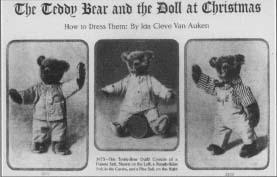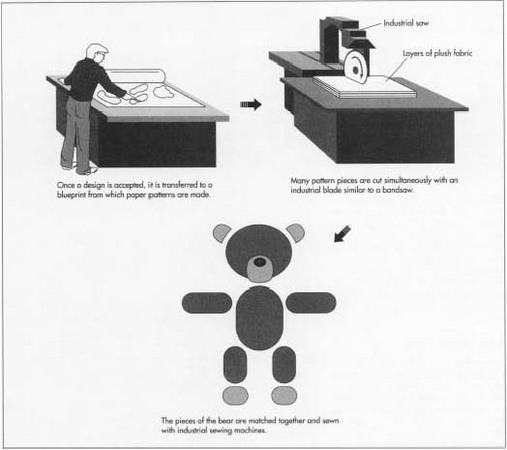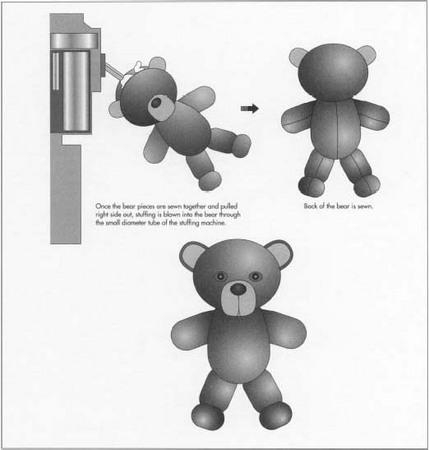Teddy Bear
Background
Most people born in this century have probably encountered teddy bears during their lives, for the teddy bear was developed around the turn of the century. Toy bears developed out of admiration for real bears. About 110,000 years ago, Neanderthal hunters collected skulls of a large brown bear (now extinct) in a shrine where the Cult of the Bear worshiped for over 50,000 years. In modern times, the bear is still considered a symbol of strength, courage, and endurance. Bears share many characteristics with humans, including the abilities to stand upright and to hug, and they also fiercely protect their cubs. Bears are sometimes called the "clowns of the woods" because they dance, sit on their haunches, and roll head over hind paws.
In medieval stories, Bruin the bear was a popular character. In Russia, the bear of folklore evolved into a caricature named "Mishka." The rest of the world learned of Mishka during the 1980 Olympic Games when he became the mascot of the games and a collectible toy. Since the teddy bear's invention, Winnie-the-Pooh, Paddington Bear, Big Teddy and Little Teddy (characters in a set of stories by H. C. Craddock), Yogi and Boo-Boo Bear, Smokey, and Sesame Street's Fozzie bear have become much loved friends and toys from the bear kingdom. Psychologists explain our connection with the teddy bear as "transitional;" children rely on teddies as secretive confidants who help them move away from total dependence on their parents.
History
The teddy bear was born in two parts of the world at about the same time. In 1903 in Giengen, Germany, Margarete Steiff made toy animals out of felt in a small factory owned by her family. Her nephew, Richard Stieff, encouraged her to make a bear based on his sketches following a visit to the Stuttgart Zoo.
Margarete was afraid a toy bear would be too frightening, so she softened the bear's snout into a friendly, pert nose and gave him a slightly hunched back like a real bear. She cut a pattern out of brown mohair pile fabric and created a bear whose head, arms, and legs were articulated so they could move independently and so the bear could sit or stand. The toy was stuffed with excelsior (wood shavings used as packing material), and he had shoe-button eyes and an embroidered nose and other features. At a toy show in Leipzig, Germany, Richard displayed the bear, which caught the attention of an American toy buyer who ordered 3,000 bears. Steiff bears in many variations from Margarete's original have been made in the Steiff factory in Germany ever since, where thousands are now produced every day.
Meanwhile, in the United States, President Theodore Roosevelt was becoming known as a champion of the natural wonders and wildlife of America. While on a diplomatic mission to settle the disputed boundary between the states of Louisiana and Mississippi, he went hunting for the brown bear famous in the area, but the bears eluded him. His hosts did not want to disappoint the President, so they captured a bear for him. But the captive was only a cub, and the President would not hurt a creature who had not been fairly hunted. A political cartoonist named Clifford Berryman drew a characterization of the bespectacled President and the fluffy, sweet-faced bear he had refused to shoot, and the cartoon appeared in newspapers on November 16, 1902.
At a candy store in Brooklyn, New York, Morris Michtom read about the President and the cub. His wife, Rose, made toy ponies to sell in their shop. Mr. Michtom asked her to make a bear instead, and they began selling "Teddy's Bears" in honor of the President. Curiously, the Michtom's bears, later known as Morris bears, looked much like those of Margarete Steiff with button eyes, embroidered mouths and noses, articulated joints that allowed limbs and heads to move, cloth soles, and felt claws.
Michtom wrote to the President for permission to name the bears after him, and the President officially approved the teddy bear. The Steiffs claimed that some of first shipment of 3,000 bears were used to decorate tables at a wedding President Roosevelt attended. By 1907, almost one million teddy bears had been sold, and, since the early 1950s, bear sales have typically been on the order of one-quarter of a million bears per year.
Raw Materials
The original teddy bears were made (on both sides of the Atlantic) with mohair fabric "fur" that was commonly used for upholstery, black leather shoe-button eyes, and excelsior packing as stuffing. In the 1920s, glass eyes were used, but both the glass and button eyes pulled off easily. In 1948, Wendy Boston patented a screw-in eye made of molded nylon. These were supplanted in the 1950s by plastic eyes mounted on stems and fastened securely to the inside of the fabric with grommets or washers. These safety eyes became standard by the 1960s.

The teddy bear craze reached its height in America between 1906 and 1908, coinciding with President Theodore "Teddy" Roosevelt's second term in office. Across the country, adults and children alike were going "teddy bear mad."
In addition to the huge variety of regular teddy bears produced by manufacturers both at home and abroad, many unusual teddy bears were also introduced at this time. For example, a "Laughing Roosevelt Bear" was designed to reproduce President Roosevelt's toothy grin. A self-whistling bear produced a whistling sound when it was turned upside down and back upright again. An "Electric Eye" bear had a mechanism in its stomach that, when pressed, activated lights in its eyes (unfortunately, these mechanisms quickly broke).
Also during these years, teddy bear images appeared on many other consumer goods, including automobile accessories, baby rattles, jigsaw puzzles, postcards and greeting cards, and even the cover for a hotwater bottle. And it was in 1907 that John W. Bratton composed "The Teddy Bear Two-Step," to become famous later as the tune for "The Teddy Bear's Picnic."
Some teddy bear lovers enjoyed humanizing their bears by dressing them up in doll-like clothes. The above photos feature a set of teddy-bear clothes that could be sewn for children as a Christmas gift. The pattern, which cost 15 cents, came in three sizes to fit 12-, 16-, and 20-inch bears. The article that accompanied these photos claimed that, "Even the crossest teddy bear would be pleased if he found this nice set of clothes in his Christmas stocking!"
Donna R. Braden
Changes have also occurred in the construction of articulated bears. Materials for the original designs included disks and cotter pins (twistable fasteners) that attached separately made arms, legs, and heads to a body that had to be firmly stuffed to support the pins. The early disks were made of wood with leather coverings to protect the outer fur. Companies using this process today have substituted plastic disks, but the manufacture is still largely

Today's materials are most varied in fabric. Plushes made of many fibers are popular because they are fur-like. Early bears were made of mohair that consisted of Angora (goat's wool), sheep's wool, rayon, or silk. Today's plush may be wool, silk, rayon, nylon, other synthetics, or combinations of fibers. Velvet or velveteen (velvet made of cotton instead of silk or synthetics) is popular for its softness and range of colors. Fake fur fabrics are classics for modern bears. Fake fur is different from plush because it has a knitted instead of woven backing that is lightweight and flexible; the shaping of the fiber can eliminate sheen and closely resemble real fur with blended colors. Real fur can also be used for teddy bears, but fur bears are delicate and require special care.
Other fabrics like corduroy, denim, calico, terry cloth, and velour are also bear basics. They are selected for variety in producing durable bears of terry cloth for babies and cowboy bears of denim, for example.

Design
The design for a new model of teddy bear is first sketched by an artist experienced in toy design and the manufacturing process. Based on a sketch or conception of the planned bear, pieces of the bear are also drawn to be used in making a pattern. The pattern is cut out and assembled, and the prototype bear is examined for "character flaws." If the design prevents the bear from sitting properly, for example, or if the prototype is not appropriately cuddly or distinguished, the design is redrawn, shapes of pieces are changed, or different colors or fabrics may be used to make another prototype. Many trials may be required to perfect the design before it is ready for large-scale manufacture. Factors such as popular interests and headlines may be considered in planning new designs where a respectable volume of sales is needed to justify manufacture. For instance, a bear producer in California sells a stuffed bear resembling the bruin on the California state flag, but this item would not necessarily sell well elsewhere.
The Manufacturing
Process
- After the design is accepted, it is transferred to a blueprint from which paper patterns are made. The shapes are cut out and pinned to fabric. Many layers of plush may be stacked with the pattern pinned on the top, and a cutter with a blade much like a band saw is used to cut out many pieces at one time. Rows of workers sit behind industrial sewing machines. Each is responsible for one style of bear. He or she will assemble the small pieces first, add the eyes and grommet attachments to the face, and then stitch the parts together. The bears are inside out with their seams exposed and openings down the long seam in the back. Finally, the bears are pulled right side out and dispatched to be stuffed. The volume a worker produces depends on the type of bear; one may produce 35 to 45 baby bears in one day or eight or nine larger species.
- The stitched bear is then stuffed. The manufacturer purchases polyester fiber in 500 lb (227 kg) bales in which the fiber is tightly packed. The fiber is dual density with a very fine fiber and a thicker, slightly wavy fiber; together, these fibers have the most desirable packing quality for stuffing animals. Because the polyester comes so tightly packed, batches of it are tossed into a picker, which is a barrel lined with spikes that fluffs the stuffing. The fluffed material is blown by air into a stuffing machine. These machines have evolved little since World War H, when the machines were used to stuff flight jackets for the United States Navy and Army Air Force. Air pressure blows the stuffing into the bear through a small diameter tube. The operator can manipulate the bear to direct the stuffing to various parts of the toy. A pedal release on the stuffing machine controls the puffs of stuffing. Two pushes on the pedal, for example, may be needed to pump enough stuffing from the machine's nozzle into the nose of the bear, which needs to be firm. The head, feet, and paws also need to be firm, but the body should be squeezably soft. The operator can always apply the "hug test" to evaluate satisfactory cuddliness and provide quality control from bear to bear.
- The stuffed bear is then passed to another worker, a "bear surgeon," who stitches up the opening in the back of the bear. The whole bear is then groomed. Because the plush fabric was stitched inside out, "fur" is caught in the seams and must be pulled out so the seams do not show. An electrically powered wire brush is used to fluff the seams, and the bear is then blown through an array of air jets to remove the loose fuzz and brush the fur. Final details like costumes, ribbons, and accessories are added before the bear is packaged for transport and sale.
Quality Control
Although teddy bears are mass produced, their design and production requires hands-on attention throughout the manufacturing process. Fabric cutters, assemblers, stuffing machine operators, and bear surgeons, groomers, and dressers all share great pride in knowing their product will give and receive much love over the years of its life. Hand-production ensures that the bears are inspected at every step in their manufacture, and that mistakes do not reach the packaging department.
Byproducts/Waste
There are no byproducts from the manufacture of teddy bears, although there are co-products consisting of other types of stuffed animals and dolls. Small stuffed creatures are sometimes designed with pattern pieces to fit between bear segments so fabric is not wasted. Fabric scraps and errant stuffing constitute most of the waste from bear production, and this material cannot be recycled and is disposed.
Safety concerns are important in the bear factory. The machinery is powered by electricity, requiring safety precautions; fabric cutters, sewing machines, wire brushes, and other machines are equipped with emergency shutoffs and other safety devices. Operators wear masks over their mouths and noses to prevent them from inhaling the airborne fluff. Safety glasses are also worn during some operations.
The Future
The future for teddy bears can only be a picnic. New interpretations of this much-loved creature follow trends in movies, television, and toy fashion from character bears to miniature, beanbag-like versions that are inexpensive and collectible. A teddy bear has even flown on the Space Shuttle when, in February 1995, Magellan T. Bear from the Elk Creek Elementary School in Pine, Colorado, joined a NASA mission as the school's ambassador. Teddy bears are popular with children, obviously, but also with adult collectors who build on their childhood friends and often invest in limited editions or bears made from prized designs and rare materials. In a world with increasing emphasis on technology, teddy bears remind us of our childhood and provide an unlimited supply of fuzzy hugs.
Where to Learn More
Books
Bialosky, Peggy and Alan. The Teddy Bear Catalog. Workman Publishing, 1980.
Bork, Christina. Big Bear's Book by Himself. Raben & Sorgren, 1994.
Bull, Peter. The Hug of Teddy Bears. NAL-Dutton, 1984.
Cockrill, Pauline. The Teddy Bear Encyclopedia. Dorling Kindersley, 1993.
Hillier, Mary. Teddy Bears: A Celebration. Beaufort Books, 1985.
Hutchings, Margaret. Teddy Bears and How to Make Them. Dover Publications, 1964.
Kay, Helen. The First Teddy Bear. Stemmer House, 1985.
King, Constance Eileen. The Encyclopedia of Toys. Crown Publishers, Inc., 1978; pp. 81-84.
Morris, Ramona and Desmond. Men and Pandas: Why People Like Pandas (and Teddy Bears) So Much. McGraw-Hill, 1966.
Schoonmaker, Patricia N. A Collector's History of the Teddy Bear. Hobby House Press, 1981.
Vosburg Hall, Carolyn. The Teddy Bear Craft Book. Van Nostrand Reinhold Company, 1983.
Periodicals
Coy, Peter. "How the talking 'TV Teddy' tunes in." Business Week, October 25, 1993, p. 95.
Luscombe, Belinda. "Bearable Occasion." Time, October 7,1996, p. 101.
Merkin, Daphne. "The Meaning of a Bear Market." New Yorker, December 26, 1994-January 2, 1995, p. 52.
"The Fur Flies." People, February 6, 1995, p. 54.
"The Ultimate Bear Market." Economist, September 29, 1990, p. 66.
— Gillian S. Holmes
Comment about this article, ask questions, or add new information about this topic: